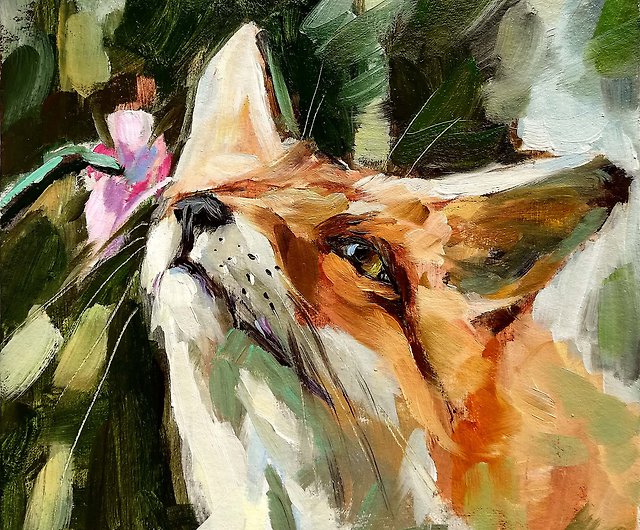Checking out Everything About Oil Paintings: A Guide to Comprehending Their Appeal and Value
Oil paintings have actually astounded target markets for centuries, using a peek into the creative mastery of various eras. Their abundant background is intertwined with cutting-edge methods and profound emotional expression. Recognizing the materials and techniques behind these artworks can boost admiration. In addition, the market for oil paintings offers chances for collectors and financiers alike. As one discovers this interesting world, the concern occurs: what makes an oil paint genuinely important?
The History of Oil Paint: A Journey Via Time
Oil painting has roots that date back to old times, it genuinely flourished throughout the Renaissance, when artists found its versatility and rich color capacity. Early instances can be traced to the 7th century, with strategies progressing notably throughout cultures. The tool became famous in Northern Europe in the 15th century, particularly via the works of musicians like Jan van Eyck, that pioneered its use for detailed realistic look and dynamic tones. This period marked a separation from tempera paints, enabling better depth and structure. As oil painting spread, it affected many artists, resulting in work of arts by prominent numbers such as Leonardo da Vinci and Rembrandt. The tool's legacy continues, shaping the art world well into contemporary times.
Understanding Oil Repaints: Materials and Techniques
As artists discover the globe of oil paints, they encounter a diverse variety of products and techniques that define this medium. The main elements of oil paint consist of pigments, which give color, and drying out oils, such as linseed, that bind the pigments and facilitate application. Various additives can customize the paint's structure and drying out time, boosting versatility. Techniques like glazing, where transparent layers are developed up, and impasto, which includes using thick paint, enable various aesthetic impacts. Furthermore, the use of brushes, palette blades, and also fingers can create distinct structures and surfaces. Comprehending these materials and methods allows artists to completely reveal their creativity and accomplish the wanted influence in their artwork.
The Role of Shade in Oil Paints
Shade plays a crucial role in oil paintings, affecting both visual allure and psychological resonance. Recognizing color theory essentials, including the relationships in between shades, can boost an artist's ability to share mood and ambience. In addition, understanding shade mixing strategies permits better depth and splendor in a painting's combination.

Shade Theory Basics
Understanding shade theory is essential for artists dealing with oil paints, as it develops the foundation for producing visually interesting and unified structures. Color concept incorporates the research study of how shades interact, the shade wheel, and the connections between key, secondary, and tertiary shades. Artists make use of complementary shades to enhance contrasts and develop focal factors, while comparable shades promote unity and cohesiveness within an item. Additionally, the principles of warm and cool shades affect the understanding of deepness and space in a painting. Comprehending these concepts permits artists to control color effectively, leading the customer's eye and communicating their desired message. Mastery of shade theory eventually enriches a musician's ability to communicate feelings and ideas via their work.
Psychological Impact of Shade
The psychological effect of shade in oil paintings plays a crucial function in just how visitors connect and perceive with art work. Colors evoke particular sensations and moods, affecting the visitor's mood. Cozy colors like oranges and reds can develop a feeling of heat and power, while cool tones such as blues and greens typically evoke calmness or self-questioning. Artists tactically select shade schemes to boost narrative components, leading the target market's psychological journey. The saturation and contrast of colors further amplify these results, drawing focus and developing focus. Eventually, the interplay of colors in oil paintings not just boosts their visual charm however also works as a powerful medium for psychological expression, improving the customer's experience and analysis.
Color Combining Techniques
While several facets of oil painting add to the general composition, grasping color mixing strategies is vital for achieving desired results and depth. Color blending can be approached through numerous techniques, including the subtractive and additive procedures. Additive mixing involves incorporating colors of light, while subtractive blending depends on pigments, where colors mix to produce brand-new tones. Musicians often make use of a restricted palette to develop harmonious jobs, recognizing the relationships in between primary, second, and tertiary colors. Strategies such as glazing and scumbling additionally enhance deepness and luminosity. By masterfully mixing colors, a musician can evoke feelings, produce centerpieces, and attain a sense of realistic look, inevitably raising the paint's psychological and visual effect.
Famous Oil Painters and Their Iconic Functions

Famous for their mastery of color and strategy, oil painters have actually created a few of one of the most well known art work in background. Renowned musicians like Vincent van Gogh mesmerized target markets with his stirring brushwork in "Starry Night," while Claude Monet's "Perception, Sunup" laid the groundwork for Impressionism. Leonardo da Vinci's "Mona Lisa" stays a long-lasting symbol of artistic brilliant, showcasing his ability in capturing human expression. On the other hand, Rembrandt's "The Night Watch" shows his cutting-edge usage of light and darkness. Other significant numbers consist of Pablo Picasso, that changed modern art with his strong experimentation in works like "Les Demoiselles d'Avignon," and Georgia O'Keeffe, whose vibrant representations of landscapes and blossoms helped specify American modernism. Each artist's distinct design contributed substantially to the oil painting landscape.
Just how to Review the High Quality of an Oil Painting
Assessing the high quality of an oil painting entails a cautious assessment of workmanship methods, as well as an evaluation of shade and composition. Observing brushwork, layering, and the application of paint can disclose the musician's skill degree. In addition, the interplay of shades and the general arrangement of components contribute substantially to the painting's visual worth.
Assessing Workmanship Methods
A precise evaluation of craftsmanship strategies is necessary for identifying the top quality of an oil painting. Critics ought to initially analyze the application of paint; thick, distinctive brushstrokes may recommend a competent hand, while extremely uniform applications might indicate an absence of deepness. oil paintings for sale. The layering technique is additionally crucial; the existence of lusters and differed density can improve luminance and intricacy. In addition, the high quality of the materials used, such as the canvas and pigments, plays a considerable role in sturdiness and overall visual. Focus to information in components like sides and shifts between colors reflects the artist's commitment to their craft. Inevitably, these methods add to the painting's emotional influence and market worth, serving as signs of the musician's ability and intent
Evaluating Shade and Composition
While assessing the high quality of an oil painting, one need to concentrate on the interplay of shade and structure, as these components are essential to the art work's overall effect. Shade options can stimulate feelings and develop mood; for that reason, the artist's combination must be checked out for consistency and contrast. A well-balanced composition guides the customer's eye and creates a feeling of unity. Musicians frequently utilize strategies like the rule of thirds or leading lines to improve aesthetic passion. In addition, making use of light and darkness can include deepness, boosting the three-dimensionality of the paint. Ultimately, a successful oil paint weds shade and structure, engaging the audience and inviting a deeper appreciation of the artist's vision and strategy.
Taking care of and Preserving Oil Paintings
Appropriate care and preservation of oil paintings is vital for maintaining their integrity and long life. To shield these art work, it is important to display them away from straight sunlight, which can trigger fading and staining. Keeping a steady atmosphere with regulated temperature level and moisture additional aids in avoiding damage. Cleansing ought to be done gently making use of a soft, dry cloth, preventing any type of harsh chemicals that can hurt the paint or varnish. Normal examinations for indications of deterioration, such as flaking or fracturing, are recommended. When keeping or delivering oil paintings, correct cushioning and framework are needed to avoid physical damage. Ultimately, thorough treatment contributes to the aesthetic charm and worth of oil paints gradually.
The Market for Oil Paintings: Accumulating and Investing
Comprehending the marketplace dynamics for oil paintings is crucial for collection agencies and capitalists alike. The worth of these artworks is influenced by numerous factors, including the musician's reputation, historical relevance, and existing trends. Collectors commonly seek pieces that reverberate personally while considering possible gratitude in worth. Galleries and public auctions work as key venues for acquiring and selling, with rates fluctuating based upon need and rarity. Spending in oil paints calls for research right into the market, in addition to an understanding of authenticity and provenance. In addition, emerging musicians may use opportunities for considerable returns, while developed names can command high costs. On the whole, a tactical strategy to collecting can produce both visual pleasure and monetary benefits.

Frequently Asked Inquiries
What Are the Environmental Impacts of Oil Paint Materials?
The ecological impacts of oil paint materials include the release of unpredictable organic substances (VOCs), damaging waste generation, and source extraction for pigments. These variables add to air pollution and environmental destruction, increasing problems among eco conscious musicians and customers.
Just How Do Various Canvases Influence Oil Paint Outcomes?
Various canvases influence oil paint results considerably. Surface area, appearance, and absorbency high quality can change paint application, drying times, and color vibrancy. Artists typically select particular canvases to achieve desired effects and boost their imaginative expression.
Can Oil Paintings Be Brought Back if Damaged?
If harmed, Oil paintings can indeed be recovered. Expert conservators use various strategies to fix splits, clean surfaces, and address staining, making sure that the artwork retains its initial appeal and value for future generations.
What Are the Indicators of an Initial Oil Painting?
The indicators of an original oil paint consist of visible brush strokes, texture variants, and an unequal canvas weave (oil paintings for sale). In addition, credibility may be confirmed through provenance, trademarks, and the presence of a varnish layer one-of-a-kind to oil mediums
Just How Has Modern Technology Influenced Modern Oil Painting Techniques?
Modern technology has greatly affected modern oil paint techniques by presenting digital devices for planning, enhanced materials for appearance and durability, and on-line platforms for sharing and marketing art, therefore expanding musicians' imaginative possibilities and target market reach. Oil painting has origins that date back to old times, it genuinely flourished throughout the Renaissance, when musicians discovered its adaptability and abundant color possibility. The psychological click here impact of shade in oil paints plays a crucial function in just how viewers connect and view with art work. While several aspects of oil painting add to the general composition, mastering shade mixing strategies is necessary for achieving wanted impacts and depth. Assessing the high quality of an oil painting entails a cautious assessment of workmanship techniques, as well as an evaluation of color and make-up. While examining the quality of an oil paint, one must concentrate on the interplay of shade and composition, as these components are essential to the art work's overall influence.